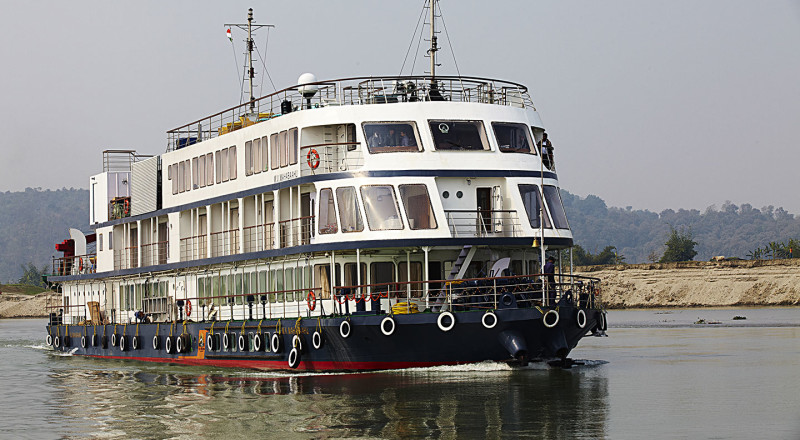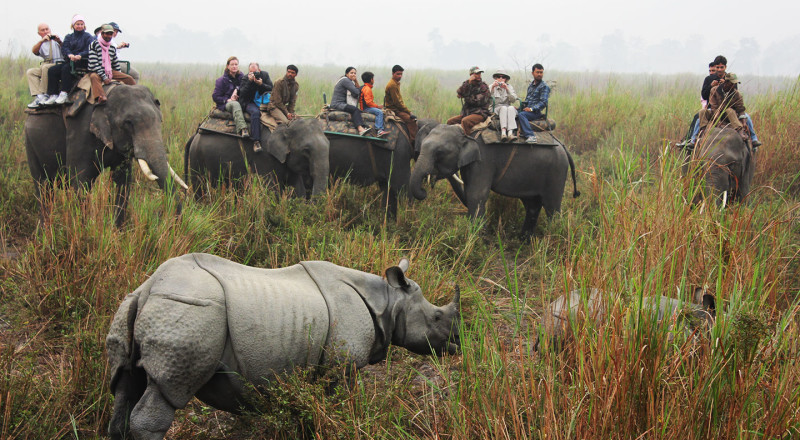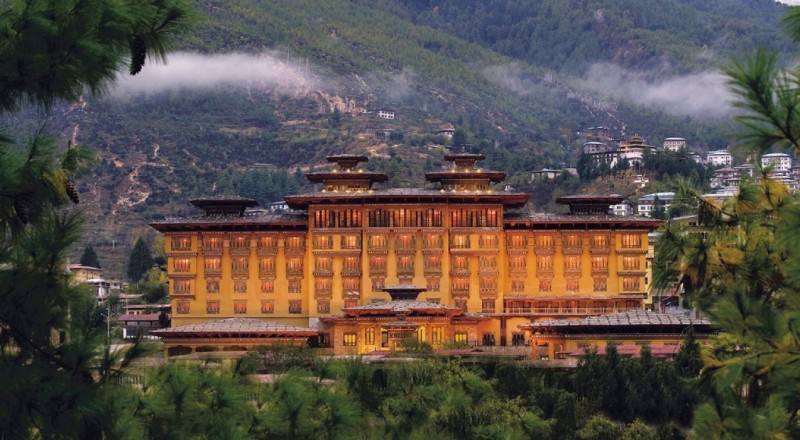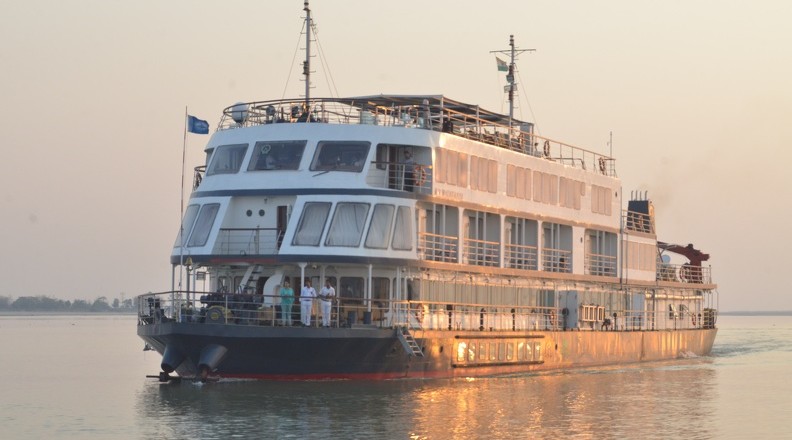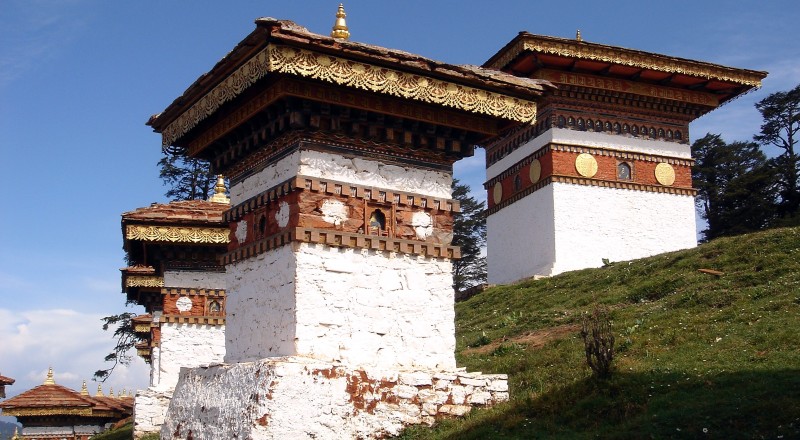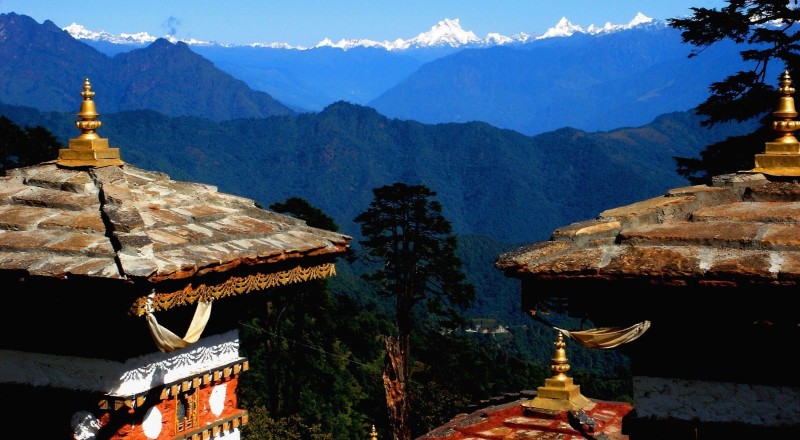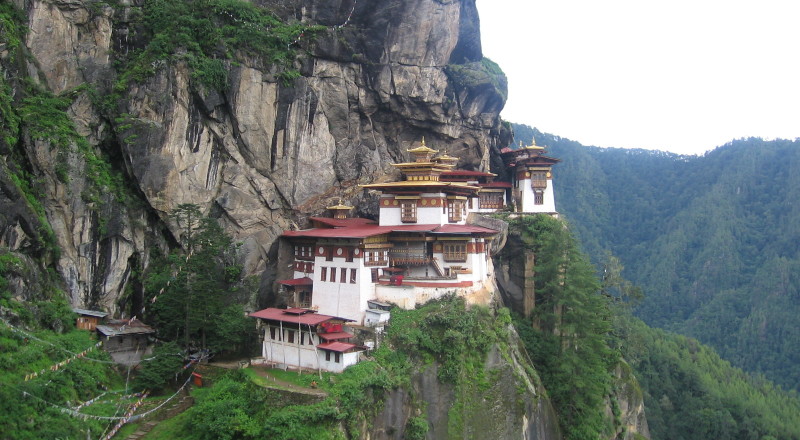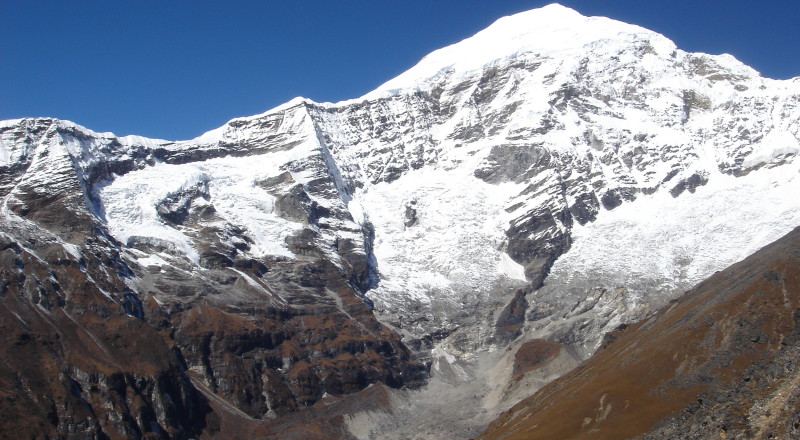This is a journey like never before. Combining the beauty & pristine Kingdom of Bhutan where there are more trees than people and Assam’s mighty Brahmaputra River which overpowers the landscape and has shaped both culture and the environment.
Itinerary
Day 1 : Saturday - Arrive Kolkata
After clearing immigration and customs, step into the receiving area where our representative will meet you and escort you to your hotel.
Rest of the day is at leisure.
Overnight at the Hotel
Day 2 : Sunday - Kolkata
Kolkata the city of joy as it is called is also commonly considered as the ‘Paris of the East’ as there’s a happy amalgamation of different cultures, styles and moods, coupled along with numerous forms of industries and commerce and politics. Kolkata mainly gained importance in the times of British rule as it had been the capital of India till the year1912. At present, although it is no more the capital of India, it is the capital of West Bengal and is one of the most important places of cultural workshop and industrial centre.
After breakfast, visit the Victoria Memorial. This marble-white monument is one of the most fascinating landmarks of Kolkata.
Here, come face to face with miniature paintings and images of Queen Mary, King George V and Queen Victoria. Of special importance are the Queen’s dresses, the famous Rosewood piano, the Whispering Gallery in the dome and numerous artillery weapons used in the Battle of Plassey.
St. Paul’s Cathedral, built in the Indo-Gothic style of architecture, and was built in the year 1847 by Major W.N. Forbes of the East India Company. The height of the Cathedral is 201 ft. This Cathedral has the rare distinction of being the first Episcopal Church built in this part of the world. The peak of St. Paul’s Cathedral has been designed as a replica of the famous Canterbury Cathedral’s Henry Tower.
Thereafter visit Mother Teresa’s House, called ‘Nirmal Hriday,’ and also visit Shishu Bhawan, located near her house. Mother Teresa’s great work of caring for abandoned children on the streets of Kolkata is carried out at this center. Watch the children’s face light up with just one smile of yours.
Overnight at the Hotel (B)
Day 3 : Monday - Fly Kolkata to Paro then drive to Thimpu
After early breakfast, drive to the airport to board flight to Paro. Fly into Himalayas with Druk Air, Bhutan’s National Air Carrier. The green walls of the hills known as dooars or gateways, in to Bhutan from the plains of India rise ever higher as the plane flies north towards the
Tibetan border. Silvery rivers rush along the valleys, waterfalls plunge down the forested mountainsides, and to the north, the great snow-capped peaks of the inner Himalayas rise up to the heavens. Farm houses dot the hillsides on either side of the plane.
As the aircraft enters the Paro valley, look down and you will see the Paro Dzong on the hillside overlooking Paro Chu (river) with Ta Dzong, formerly a watchtower and now the National Museum, above it. You will be received by our representative at the airport and transfer to Thimphu, the modern capital town of Bhutan.
Thimphu, earlier a small settlement was developed in to a town and became the new capital of Bhutan. The city sprawls across the western slopes of the Wang Chuu river valley, with several government offices located around Trashichoe Dzong, the 17th Century fortress monastery is today the seat of Bhutanese government. The main thoroughfare is lined with shops, restaurants, retail arcades and public buildings. With the population of about 90,000 it is perhaps still the world’s only capital city without a traffic light.
Visit Buddha Point (Kuensel Phodrang). Located at a short drive from Thimphu city centre, visitors can get a good overview of the Thimphu valley from the Buddha point (Kuensel Phodrang). You can pay your obeisance and offer prayers to the Buddha, the largest statue in the country and then walk around and take a glimpse of the valley.
Overnight at Hotel (B, L, D)
Day 4 : Tuesday - Thimpu
After breakfast, start with a visit of National Library (closed on sat & sun ), which holds a vast collection of ancient Buddhist texts and manuscripts, some dating back several hundred years, as well as modern academic books mainly on Himalayan culture and religion.
Also visit nearby Institute for Zorig Chusum: Commonly known as Arts & Crafts School or Painting School (closed on Saturday & Sunday), the Institute offers a six- year course on the 13 traditional arts and crafts of Bhutan. On a visit, one can see students learning the various skills taught at the school.
Also visit the Textile (closed on Sunday) and Folk heritage Museum – both of which opened in 2001, provide fascinating insights into Bhutanese material culture and way of life Simply Bhutan – an exclusive project under the Bhutan Youth Development Fund. It is a living Museum and Studio encapsulating the cultural heritage of the Bhutanese people. The infrastructure portrays ancient Bhutanese architecture which is being lost to modernization.
King’s Memorial Chorten continuously circumambulator by people, murmuring mantras and spinning their prayer wheels. Construction of this landmark was the idea of Bhutan’s third king, His Majesty Jigme Dorji Wangchuk (“the father of modern Bhutan”) who has wished to erect monument to world peace and prosperity. Completed in 1974 after his untimely death, it serves both as a memorial to the Late King and as a monument to peace.
Tashichhodzong: This impressive fortress/monastery houses Secretariat building, the throne room of His Majesty, the King and various government offices. It is also the summer residence of Chief Abbot and central monk body.
Overnight at Hotel (B, L, D)
Day 5 : Wednesday - Thimpu to Punakha (approx. 3.5 hours)
Thimphu – Punakha by road: Approx. 80 km / 50 miles/ 3½ hour drive (Altitude 1300 m)
Today morning drive to Punakha across Dochu La (3,088m/ 10,130 ft.) stopping briefly here to take in the view and admire the Chorten, mani wall, and prayer flags which decorate the highest point on the road. If skies are clear, the following peaks can be seen from this pass (left to right): Masagang (7,158m), Tsendagang (6,960m), Terigang (7,060m ), Jejegangphugang (7,158 mt), Kangphugang (7,170 m ) Zongphugang (7, 060 m ), a table mountain that dominates the isolated region of Lunana – finally Gangkar puensum, the highest peak in Bhutan at7,497m.
Punakha served as the capital of Bhutan until and still it is the winter seat of Je Khenpo (the chief abbot). Blessed with temperate climate and owing to its natural drainage from Pho Chhu (male) and Mo Chhu (female) rivers, the Punakha valley produces abundant crops and fruits.
En-route, take a short excursion to Chimi Lakhang, situated on a hillock in the centre of the valley, is dedicated to Lama Drukpa Kuenley, who in the late 15th century used humour, songs and outrageous behaviour to dramatise his teachings and due to this also known as „Divine Madman‟. This temple is also known as the temple of fertility. It is widely believed that couples who do not have children and wanting one, if they pray at this temple, they are usually blessed with a child very soon. It is about 30 minute walk across field from the road to the temple. The trail leads across rice fields to the tiny settlement of Pana, meaning „field‟. It then follows a tiny stream downhill to Yoaka and across more fields before making a short climb to Chimi Lhakhang.
Thereafter visit the majestic Punakha Dzong built strategically at the junction of Pho Chhu and Mo Chhu rivers in 1637 by Shabdrung Ngawang Namgyal to serve as the religious and administrative centre of the region, Punakha Dzong has played an important role in Bhutan’s history. Damaged by four catastrophic fires and an earthquake, the Dzong has been fully restored by the present King.
Overnight at Hotel (B, L, D)
Day 6 : Thursday -Punakha to Paro (approx. 4.5 hours)
Punakha – Paro by road: Approx. 125km/ 79 miles/ 4½ hour drive) (Altitude 2200m)
Breakfast at the Hotel , then drive back to Paro descending back down from Dochu La, follow the way back up the dramatic Wang Chhu and Paro Chhu river valleys, before crossing through Paro Town towards the north end of the valley. The beautiful valley of Paro encapsulates within itself a rich culture, scenic beauty and hundreds of myths and legends. It is home to many of Bhutan’s oldest temples and monasteries, National Museum and country’s only airport. Mount. Chomolhari (7,314m) reigns in white glory at the northern end of the valley and its glacial water plunge through deep gorges to form Pa Chhu (Paro river). Paro is also one of the most fertile valleys in the Kingdom producing a bulk of the locally famous red rice from its terraced fields. Later in the afternoon proceed to visit:
Ta Dzong, originally built as Watchtower, which now houses National Museum. The extensive collection includes antique thangkha paintings, textiles, weapons & armour, household objects and a rich assortment of natural and historic artefacts. After the visit walk down the trail to visit Rinpung Dzong, meaning (“fortress of the heap of jewels”), which has a long and fascinating history. Along the wooden galleries lining the inner courtyard are fine wall paintings illustrating Buddhist lore such as four friends, the old man of long life, the wheel of life, scenes from the life of Milarepa, Mount. Sumeru and other cosmic Mandala.
Overnight at Hotel (B, L, D)
Day 7 - Friday - Paro
Morning after breakfast – proceed for an excursion to Taktsang Lhakhang (5hrs hike total): perched on the side of a cliff 900m above the Paro Valley floor , it is undoubtedly one of the most famous of Bhutan’s monasteries. Lore has it that Guru Rinpoche arrived here on the back of a tigress and meditated at this monastery thus the name Tiger’s Nest‟. This site has been recognized as a most sacred place and visited by Shabdrung Ngawang Namgyal in 1646 and now visited by all Bhutanese at least once in their lifetime. On 19 April, 1998, a fire severely damaged the main structure of building but now this Bhutanese jewel has been restored to its original splendour.
Later on the drive back to Paro, visit the 7th century Kyichu Lhakhang, one of the 108 temples built in the Himalayas by Tibetan King, Songtsen Gampo. The building of this temple marks the introduction of Buddhism in Bhutan.
Overnight at Hotel (B, L, D)
Day 8 - Saturday - Paro to Guwahati (Flight)
Early this morning transfer to Paro airport to connect with your flight to Guwahati. On arrival our representative will meet you at the receiving area & transfer to the hotel.
Rest of the day will be at leisure.
Overnight at Hotel (B)
Day 9 : Sunday - Guwahati - Board MV Mahabaahu
With packed lunch, we drive through the busy streets to the Kamakhya Temple. This Temple is devoted to Kama Khya, the eternal Feminine- the goddess of desire. After the Temple visit, we drive towards Pandu Port and check into the Cruise and gather on the open deck to enjoy the first sail!!!
A quick orientation and we deboard for a short visit of the picturesque Peacock Island, the smallest island on the Brahmaputra (flight time permitting) famous for the highly endangered Golden Langur. It would be a good idea to have one’s binoculars and cameras at hand.
Proceed into the evening with a talk on ‘Kamakhya and the occult in Assam’. Soon MV Mahabaahu drops anchor and the evening follows into the welcome dinner.
Overnight on board MV Mahabaahu (B, L, D)
Day 10 - Monday - Full Day Sailing - visit village
MV Mahabaahu lifts anchor early. We enjoy Yoga on the deck for an hour and move on for breakfast. We enjoy a talk on ‘Assam, its geographical location in the national and international context and how it is acclaiming recognition’. MV Mahabaahu heads on towards an island that is occupied predominantly by a ‘Bangla’ speaking Muslim community who are involved in extensive farming. After visiting this village, we return to the ship for lunch and sail towards the Orang Point.
Evening sets in and over a cup of tea, we enjoy a talk on ‘The River Brahmaputra and the tribal life’. We anchor at a deserted island for the evening and enjoy a bonfire with barbeque.
NOTE: (Bonfire may be cancelled if a suitable sandbank cannot be found or if we experience inclement weather conditions)
Overnight on-board MV Mahabaahu Cruise (B, L, D)
Day 11 : Tuesday - Sail to Silghat
MV Mahabaahu sails early and we enjoy Yoga on the deck and move on for breakfast and for a talk on ‘Wild life in Kaziranga with an overview of the wild life in India’.
We sail on for the next couple of hours and enjoy a relaxed lunch as we reach Silghat.
After a talk on ‘Tea, Jute & Silk in Assam’, we take a short drive to Kaliabore Tea Estate which is a vast undulating expanse with tea bushes. We proceed to the tea factory to see the processing of the Assam Tea and getting an insight into all that goes into preparing a cup-of-tea. (The tea factory is not operational from mid-December to mid-February as it is time for pruning the tea bushes).
While returning to the ship, we visit a co-operative Jute Mill which is an interesting place to understand how jute fibre takes the form of very eco-friendly gunny bags. We enjoy a cultural evening on the ship followed by an early dinner.
Overnight on-board MV Mahabaahu Cruise (B, L, D)
Day 12 : Wednesday - Kaziranga National PArk
An early wake- up call with Tea/coffee and we set out towards the Kaziranga National Park.
The most prized inhabitant of Kaziranga is the Great One-Horned Indian Rhinoceros, but the Park is home to as many as 180 different mammals including wild elephants, tiger, deer, Asiatic wild buffalo and a rich variety of birds. We reach the Kohora Mihimukh range of the National Park and are ready to start our morning adventure. An elephant-back safari is once in a lifetime experience, to search for the elusive rhinoceros, tigers, swamp deer and hog deer and more and a large number of very interesting birds. The park never ceases to surprise its visitors!!!
After breakfast at a resort in Kaziranga, we drive on to Bagori, the Western Range of Kaziranga and get into the open jeeps for some more wildlife adventure and an extensive coverage of this magnificent park. We return to MV Mahabaahu and start sailing towards Bishwanath Ghat as we enjoy a leisurely lunch and a relaxed afternoon.
We get into the excursion boats to reach the shores of Bishwanath Ghat. We walk through the village and are struck by the simplicity of life while the weaver women surround us with their silk and cotton weaves. We enjoy some happy interaction with them. We return to the ship to enjoy an evening on a deserted island and then proceed for dinner.
Overnight on-board MV Mahabaahu (B, L, D)
Day 13 : Thursday - Dhansiri Boat Safari
We relish a relaxed breakfast over a talk on ‘The River Brahmaputra and the life that exists alongside.
We proceed for the boat safari viewing roof turtles on protruding drift wood, water lizards, otters, elephants, wild buffaloes, rhinos, darters, herons, pied kingfishers, white throated kingfishers, serpent eagles and many more. (The sightings are determined by the weather conditions).
We return to the ship for hot lunch. This evening, we enjoy the Chef’s Cooking Demonstration and sample the snacks. The evening on a deserted island with bonfire is always exclusive! We enjoy dinner on-board.
Overnight on-board MV Mahabaahu Cruise (B, L, D)
Day 14 : Friday - Mishing Village
After Yoga and breakfast, we enjoy the sail towards the Mishing Village.
The Mishings live on the banks of river in ‘Chang Ghars’ -houses with raised platforms. All Mishing women are expert weavers. We can buy the ethnic colorful cotton weaves and indulge in a dhoti tying and Mekhela Chadar (the indigenous traditional Assamese dress) wearing demonstration.
We return to the ship to enjoy a talk on ‘Sibsagar and the Ahom civilization’ and proceed to get ready for a Traditional Assamese evening.
Overnight on-board MV Mahabaahu Cruise (B, L, D)
Day 15 : Saturday - Visit Majuli / Neamati Ghat / Sibsagar
After breakfast, we enjoy a talk on ‘Majuli’– the seat of Neo –Vaishnav Culture and then proceed in our excursion boats to the mainland. Here on, a drive takes us to a scenic corner of a Satra (Monastery) for an interesting cultural performance by Satriya singers and dancers.
Next, we proceed to Kamlabari Satra to witness the Vaishnavite priests dancing to the rhythm of cymbals, drums and chanting in the temple premise. The humble dwellings of the monks are a revelation of utmost simplicity.We enjoy lunch on MV Mahabaahu as we sail towards Neamati Ghat.
Post lunch, we drive through the countryside to reach Sibsagar, the ancient city, built around a huge man made water tank ordered by the Ahom queen.
A town that literally means ‘the ocean of Lord Shiva.’ We notice the district is strewn with the tell-tale ruins of a powerful empire of the Ahoms. Sibsagar was the capital of the Tai-speaking Ahoms who came in the 13th Century AD to the area from the north-east and were essentially of Tibeto-Burman origin.
The Shiva Dol, constructed in the year 1734 is believed to be one of the highest Shiva temple in India.
We visit Talatal or Kareng Ghar which was the palace of the Ahom Kings and after a leisurely stroll in and around the monument, we go on to Rang Ghar which was a place for hosting wrestling bouts and buffalo fights and other entertainment or important meetings of the Royals and their guests.
We return to MV Mahabaahu by sunset for the farewell dinner.
Overnight on-board MV Mahabaahu Cruise (B, L, D)
Day 16 : Sunday - Neamati Ghat/ Jorhat/ Kolkata
.
Morning is at leisure to enjoy, Yoga/ bird watching or perhaps an early morning indulgence in the spa.
A relaxed breakfast awaits all (Baggage down prior to breakfast is requested for easy de boarding)
We drive to the Jorhat airport en-route stopping at a tea Estate to enjoy a traditional Assamese early lunch.
Depart for the airport to board the flight to Kolkata via Guwahati.
Arrive Kolkata and connect your onward international flight.
(B, L)
16 Days Bhutan & Brahmaputra River Cruise


